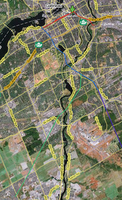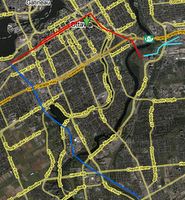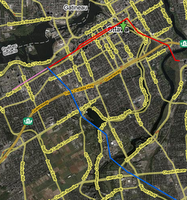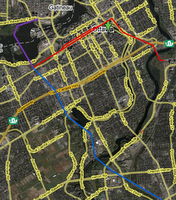Extensions to our Plan
The following are future extensions to the Friends of the O-Train plan. Each is approximately 2-3 km long and range in cost from $11 - $66 million. None of these extensions would be possible if the city's deluxe all-electric plan is taken. The money saved by using the Friends' plan could be allocated to do any of these extensions quickly and easily.
ALTA VISTA/HOSPITALS
BARRHAVEN
CASINO Du LAC LEAMY
MARCH RD KANATA
OTTAWA VIA STATION
TACHE/TERRASSE de la CHAUDIERE
TUNNEYS' PASTURE
ALTA VISTA/HOSPITALS (link) | Light rail could extended from Hurdman, along either the existing VIA rail corridor, or along the existing Transitway corridor, to enter the General Hospital complex. There would be stations accessible from CHEO, The Ottawa Hospital (General Campus), and the Rehabilitation Centre. This extension would be electric, and would extend the downtown eLRT line. The eLRT vehicles would be quiet, and would not disturb patients. Service to the hospitals would be focused on shift changes, as well as providing all-day service for visitors and out-patients. The eLRT vehicles would be able to accomodate many physically challenged patients, accomodating patients in wheel chairs. This extension would require additional eLRT vehicles to provide peak-hour service, and could provide service levels from one train per 15 minutes, up to one 600-person train every 3 minutes. This extension could be done for less than $66M (9 minute service). |
BARRHAVEN (link) | The North/South O-train line could be extended from Confederation station along the VIA line to Barrhaven. This extension would provide for stations at Colonnade (shared with a Kanata extension), as well as stations at Merivale, Fallowfield, and Jockvale Rd. The initial terminus would be Fallowfield, with one or two additional stations added to the south-west. The line would be shared with VIA rail, and this would require two passing tracks to permit VIA trains to pass the LRT vehicles. Diesel LRTs would initially provide service to Bayview, including stops at Carleton University. This line could be operational 3-4 months after an Environmental Assessment, and cost: $32M - FALLOWFIELD/jockvale (15 minute service on DLRT) $11M - FALLOWFIELD/416-park'n'ride. |
CASINO Du LAC LEAMY (link) | Light rail could be extended to the Casino de Lac Leamy. This could be done with diesel LRT (using Bombardier Talent, or Siemens Desiro). If ridership waranted, the line could be electrified at a later date. Service from South Keys would have every second train travel across the Prince-of-Wales bridge (via Bayview station) next to St.Joseph Blvd in Gatineau, terminating at the Casino. The Casino is slated to be a major transfer point of the recently announced Gatineau/STO Rapibus project. Further, the Casino has a number of parking garages which are essentially empty from 9 to 5 that would permit park'n'ride for Gatineau based employees that work in Ottawa. A station at Tache Blvd would easily connect to 14 different STO routes that originate from West Hull and Aylmer. Along with the proposed Kanata extension, this could provide for a 1-transfer service connecting Aylmer and Kanata. For Ottawa based employees who work on St.Joseph Blvd (such as at Place Vincent Massey) the LRT would provide a very efficient service. The use of the Prince of Wales bridge would significantly reduce bus congestion on Booth Street, Rideau Street, and King Edward Avenue. This extension would require one additional vehicle, some signal upgrades, and construction of stations. This extension and the Terrasse extension would cost $19M combined, and could be operational in less than 1 year, provided the politicians were all willing. |
OTTAWA VIA STATION (link) | The downtown eLRT could be extended from Hurdman to the VIA train station. This extension could be done using the transitway to the existing train transitway station or with a platform at the West end of the VIA station beside the existing VIA train platform. This would provide for cross-platform transfers from arriving VIA trains. Later the line could be extended to parts further East, as envisioned by the Rapid Transit Expansion Study. (cf Blackburn Hamlet extension, to be documented) The extension from Hurdman to VIA station could be done for $38M. |
TUNNEYS' PASTURE (link) | The downtown eLRT line could be extended from Bayview to Tunney's Pasture along the transitway. The eLRT would share the transitway with buses coming in from the west. Some bus routes (16,18,55,57,86,176) would terminate at Tunney's rather than continue to Bayview. These routes would extend North into Tunney's Pasture providing a circulator service for people getting off the LRT or other buses. Other routes would continue to terminate at the Bayview transfer station. This extension would reduce the number of transfers for East end originating employees of Health Canada and Stats Canada. The LRT heading West from Bayview would climb a ramp on the North side of the transitway trench between Parkdale and Holland Avenue and stop at grade on the East site of Holland. This would allow trains that reverse here to do so without interfering with buses travelling in the transitway trench below. A huge advantage of this for passengers is that they will not have to climb the stairs to get to the buildings at Tunney's, and they will have bus routes (16,18,55,57,86,176) going by every three minutes to take them to work. This extension could be done for less than $29M. |
TERRASSE de la CHAUDIERE (link) | Light rail could be extended to the Terrasse de la Chaudiere. This could be done with diesel LRT (using Bombardier Talent, or Siemens Desiro). This could also be done with electric LRT, extending the downtown system across the bridge into downtown Gatineau. The two options are not mutually exclusive. Service from South Keys would have every second train travel across the Prince-of-Wales bridge (via Bayview station) to stop at Montcalm and Tache near Terrasse. A station at the bus depot on Tache Blvd (at Terasse) would easily connect to 14 different STO routes that originate from West Hull and Aylmer. Many of these routes could be terminated there or at Portage, avoiding the congestion (and delays) that they experience while crossing the bridges to Ottawa. This would permit STO to run more frequent and reliable service in Gatineau. For Ottawa based employees who work at Terrasse or Place du Portage (PWGSC, Heritage, many others) the LRT would provide a very efficient service. The use of the Prince of Wales bridge would significantly reduce bus congestion on Booth Street, Ridean Street, and King Edward Avenue. This extension would require one additional diesel vehicle, some signal upgrades, and construction of stations. This extension and the Casino extension would cost $19M combined (for the diesel option) and could be operational in less than 1 year, provided the politicians were all willing. |
MARCH RD KANATA (link) | The North/South O-Train line could be extended from Confederation station, along the OCR right of way to Kanata. This is a long extension, and would have stations in Kanata (March Rd), at Herzberg Rd, the Queensway Carleton Hospital/Bells Corners, as well as stations at Woodroffe, Merivale and Colonnade. A person boarding at Kanata would have 30 minute service to Bayview, with transfers to the downtown eLRT, or possible extension to Gatineau. This extension would be done with diesel LRT vehicles. This extension has not yet been detailed priced, but may be possible for less than $41M. The train from Kanata could be extended from Confederation through Billings to Hurdman using the VIA line, rather than to Bayview. Such an extension might provide for 1-transfer service between Orleans and Kanata, avoiding downtown. (This trip would take approx. 45-50 minutes from Place d'Orleans to March Road by bus and train, compared to 1 hour 18 minutes by bus today). |

2 Comments:
The Friends of the O-Train are to be commended for making suggestions for extending service beyond their original plan.
I still do not understand the value of mixing diesel and electric trains. This really creates restrictions on the flexibility of the train network in the long-term. As far as I know, diesel and electric trains cannot share the same track and therefore the proposed trains to the south (Armstrong Road), southwest (Barrhaven) and west (Kanata) will never reach downtown. Diesel trains also cannot maneuver downtown streets and sharp turns. I don’t see how this will be competitive with existing bus service. The flexibility problem is illustrated by the extensions through Billings Bridge where it is suggested that both electric and diesel trains will operate. If we bit the bullet now and switched to an all electric system, there would be no need to have parallel diesel and electric trains and there is the possibility of having all train lines feed into downtown.
Has it been confirmed that diesel LRT and intercity VIA trains will be allowed to share the same track? The only information I have heard is that this will not be permitted. I think that before confusing the public any further, VIA rail (and Transport Canada) should be on record concerning their support or opposition to sharing track.
The Barrhaven and Kanata extensions feed into the existing O-Train. The current proposal only provides single track service on the north-south line. This will limit the frequency of trains that can use that track, and the current proposal of 7.5 minute frequency to South Keys will almost certainly be the maximum that can be handled without expensive double tracking and one of the reasons given to abandon the city’s north-south project. This would indicate that Barrhaven and Kanata trains will not be able to travel even to Bayview station, the most direct rail route into downtown from the west.
Another argument against the city’s north-south project is the sharing of roadway by trains and buses downtown, yet in the proposed extension to Tunney’s Pasture (and likely the extension to St. Laurent) buses and trains will share the same roadway. Although not mentioned, further extension west from Tunney’s Pasture may be restricted by the federal government. Will they want trains running along the scenic Ottawa River Parkway? Trains were removed from this location years ago to make the riverfront more accessible and scenic for the public.
> GC said:
>
> The Friends of the O-Train are to be commended for making suggestions
> for extending service beyond their original plan. I still do not
> understand the value of mixing diesel and electric trains.
Reply by Tim Lane:
Diesel light rail on existing corridors can be done for one half to one fifth the cost of electric light rail. A much larger diesel system could be built cheaper and sooner than an electric system. This much larger system will reach more people, and get more of them out of their cars. Net result - for any given expenditure, a diesel system will reduce road congestion, road building costs, and road maintenance costs MORE than an electric system.
Only where ridership demand is already very heavy can electric transit be justified. We have this situation downtown. The bus lanes on Slater and Albert are at capacity, and that is why we recommended concentrating ALL the ELRV fleet downtown, where
it will do the most good.
> GC said:
> This really creates restrictions on the flexibility of the train network in the
> long-term. As far as I know, diesel and electric trains cannot share
> the same track
Reply by Tim Lane:
You only know this because City staff have told you this. It is not true. In Europe, DLRT, ELRT, intercity passenger trains, and freight trains share parts of the same track.
In San Diego, and other US cities, ELRT shares the track with heavy diesel hauled freights, at different times of the day.
> GC said:
> and therefore the proposed trains to the south (Armstrong Road), southwest >(Barrhaven) and west (Kanata) will never reach downtown.
Reply by Tim Lane:
The City has already decided that many bus riders will have to take a smaller local bus to a hub where they will board a larger bus for downtown.
Under our plan, the transfer will occur closer to downtown, but in a heated complex, out of the weather, with shops and facilities that most transitway stations currently don't have - e.g., washrooms!
> GC said:
> Diesel trains also cannot manoeuvre downtown streets and sharp turns.
Reply by Tim Lane:
This is only true of the model of Diesel LRT we have now. Others are available that can handle this. And, there is no excuse, on any new right of way in virgin territory
like Riverside South and south Barrhaven, to have designed in excessively sharp curves, like the City plan has. This only slows down the trains needlessly, whether they be diesel or electric. It also results in excessive wheel wear and wheel noise.
> GC said:
> I don't see how this will be competitive with existing bus service.
Reply by Tim Lane:
The bus I was on this morning took 19 (nineteen) minutes to go from Bayview to Hurdman. Our plan for ELRT only on Albert/Slater, with no buses in the way, will guarantee crossing downtown in under 12 (twelve) minutes.
For the average person who is only going part way through downtown, the time saving on the train would more than make up for the maximum three minute, average 1.5 minute transfer time.
Even if you were going right across downtown, from beyond Bayview to beyond Hurdman, and had to transfer twice, there would still be an average time saving of about four minutes.
Remember, the multi hundred million dollar bus tunnel City Staff wanted under downtown was only going to save an average of four minutes travel time for most passengers.
> GC said:
> The flexibility problem is illustrated by the extensions through Billings Bridge >where it is suggested that both electric and diesel trains will operate. If we bit >the bullet now and switched to an all electric system, there would be no need to >have parallel diesel and electric trains and there is the possibility of having all >train lines feed into downtown.
Reply by Tim Lane:
When (not IF!) the South East Transitway is converted to ELRT, it might still be useful to have DLRT run a higher speed, limited stop service on the VIA corridor, for a fast bypass for those people travelling across town who are not going downtown.
> GC said:
> Has it been confirmed that diesel LRT and intercity VIA trains will be allowed to >share the same track? The only information I have heard is that this will not be
>permitted.
Reply by Tim Lane:
It is premature to say that "this will not be permitted". It is only City staff who are saying this.
Our experience with the O-Train has gone a long way to reassure the rail regulatory authorities of the safe nature of O-Train operations. They would require that a proper safety case be made before allowing such track sharing to occur.
> GC said:
> I think that before confusing the public any further, VIA rail (and Transport >Canada) should be on record concerning their support or opposition to sharing track.
Reply by Tim Lane:
We know, from a letter from Transport Minister Cannon's office released by radio station CFRA , that City Staff have never had any discussions with VIA on this subject.
If necessary, a second track could be built beside the VIA line.
This would still provide a shorter, faster, and cheaper to build alternative for Barrhaven rail transit to downtown than City Staff's plan. And, the faster trip would attract more riders to transit.
> GC said:
> The Barrhaven and Kanata extensions feed into the existing O-Train. The current >proposal only provides single track service on the north-south line. This will limit
>the frequency of trains that can use that track, and the current proposal of 7.5 >minute frequency to South Keys will almost certainly be the maximum that can be >handled without expensive double tracking and one of the reasons given to abandon >the city's north-south project. This would indicate that Barrhaven and Kanata trains >will not be able to travel even to Bayview station, the most direct rail route into >downtown from the west.
Reply by Tim Lane:
Single car trains from the south and the west could combine into a two car train at Confederation station for the trip to Bayview. On the way back, they could split at Confederation.
A two car train every 7.5 minutes would have a capacity of 4,560 persons per hour from Confederation to Bayview. Beyond Confederation, the single car trains would have a capacity of 2,280 persons per hour to Greenboro.
That exceeds the current bus capacity north from Greenboro in the morning peak hour by about 400 persons per hour.
If every second train that split at Confederation went to Kanata, the other to Barrhaven, each of those destinations would have a capacity of 1,140 persons per hour.
That is greater than the 2011 am peak hour boardings projected by the IBI ridership study for all three Barrhaven stations combined by about 700 riders per hour.
In other words, the FOTO plan has capacity to handle ALL the loads projected for the City Staff's plan, for a fraction of the cost.
It also would have a much lower operating cost, because of the much shorter route.
When it is deemed necessary to completely double track the existing O-Train line, this is how it could be done:
We advocate that the rock cut be widened between Prince of Wales Drive and the north portal of the Dow's Lake tunnel, to allow access to a second tunnel for the second track.
Contrary to City Staff's position, there is no excuse for this widening to take longer than a three month summer shutdown for the O-Train.
The second tunnel, when it is deemed necessary, which might not be for several more years, could then be built over the winter, when the Rideau Canal is drained.
The O-Train will continue running in the existing tunnel while the second tunnel is being built, with no service interruption during the school year.
The leaks in the existing tunnel's roof could be fixed at the same time as the new one is built. :>)
The new twin track bridges over the Rideau River south of Carleton U could be built in a staging area in the north parking lot at Carleton, near Col. By Drive.
During the same three month summer shut down for widening the rock cut, the bridges could be moved, by rail, to the Rideau River and installed there. Competent rail construction companies do this kind of work all the time.
There is absolutely no need to shut the line down for an entire three years, as City Staff want to do. All the "heavy" work that would interfere with continued O-Train
operations would be done during a single three month summer shutdown.
> GC said:
> Another argument against the city's north-south project is the sharing of roadway >by trains and buses downtown, yet in the proposed extension to Tunney's Pasture (and
>likely the extension to St. Laurent) buses and trains will share the same roadway.
Reply by Tim Lane:
This is a completely different situation. Downtown, one has to contend with cars, trucks, pedestrians, cyclists, parked cars, cars being parked, double parked delivery trucks, vehicles cutting across bus lanes to make turns, etc. None of this would exist on the Transitway proper.
And, east of Hurdman we are recommending that the ELRT line leave the Transitway and enter the VIA station at the same grade as the VIA trains.
> GC said:
> Although not mentioned, further extension west from Tunney's Pasture may be >restricted by the federal government. Will they want trains running along the scenic >Ottawa River Parkway? Trains were removed from this location years ago to make the >riverfront more accessible and scenic for the public.
Reply by Tim Lane:
West from Dominion Transitway Station will be problematic, but mostly from a aesthetic perception rather than a technical point of view.
There are gorgeous colour photos from the 1950's showing bright red Ottawa streetcars in Rockcliffe Park.
The overhead wire there was done in a less intrusive manner than elsewhere in the City.
Modern techniques for putting ELRT in a park-like setting are highly refined, and the results can be very pleasing to the eye.
And, suitable crossings at regular intervals to allow nearby residents to cross the tracks to get to the Parkland would be provided.
It would be nothing like the barrier formed by the autos & buses on the Parkway itself, which makes it dangerous to get to the riverfront.
Post a Comment
<< Home